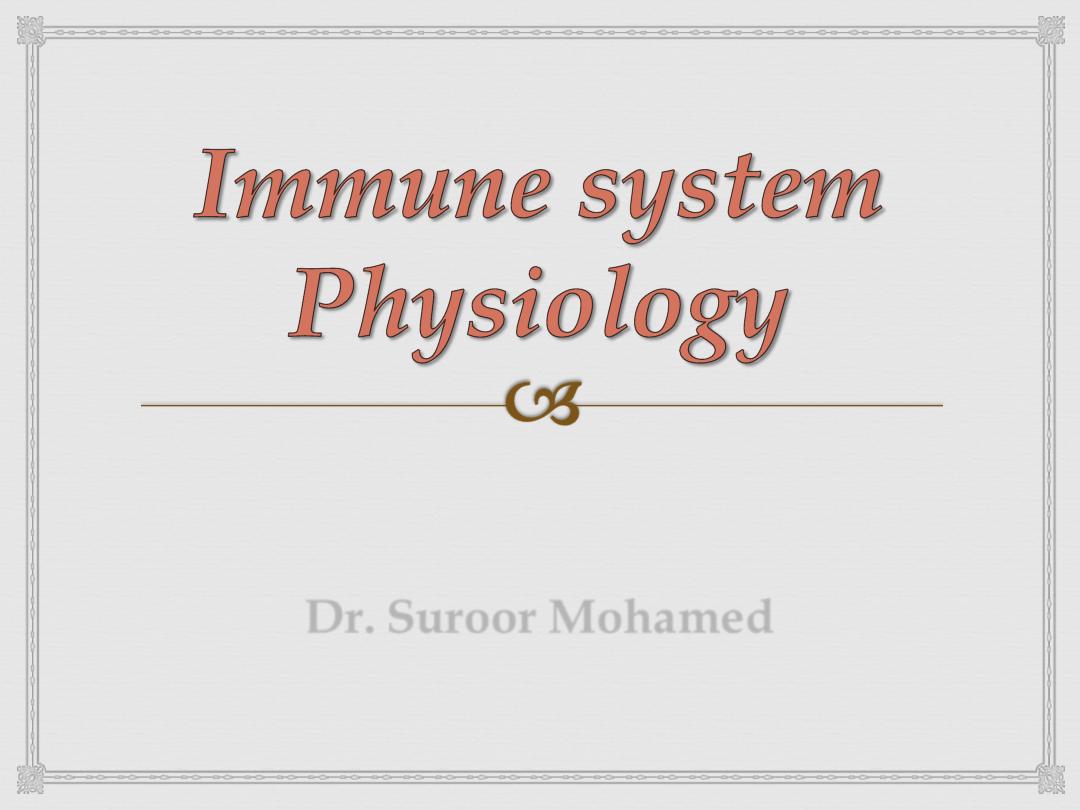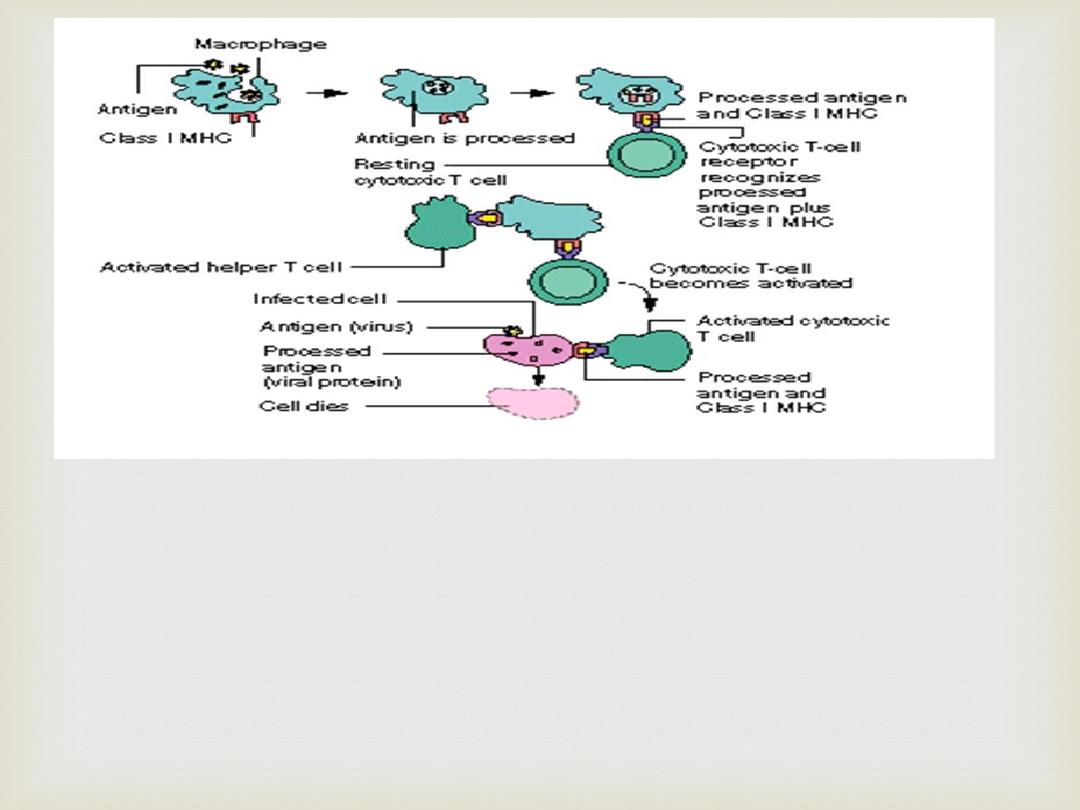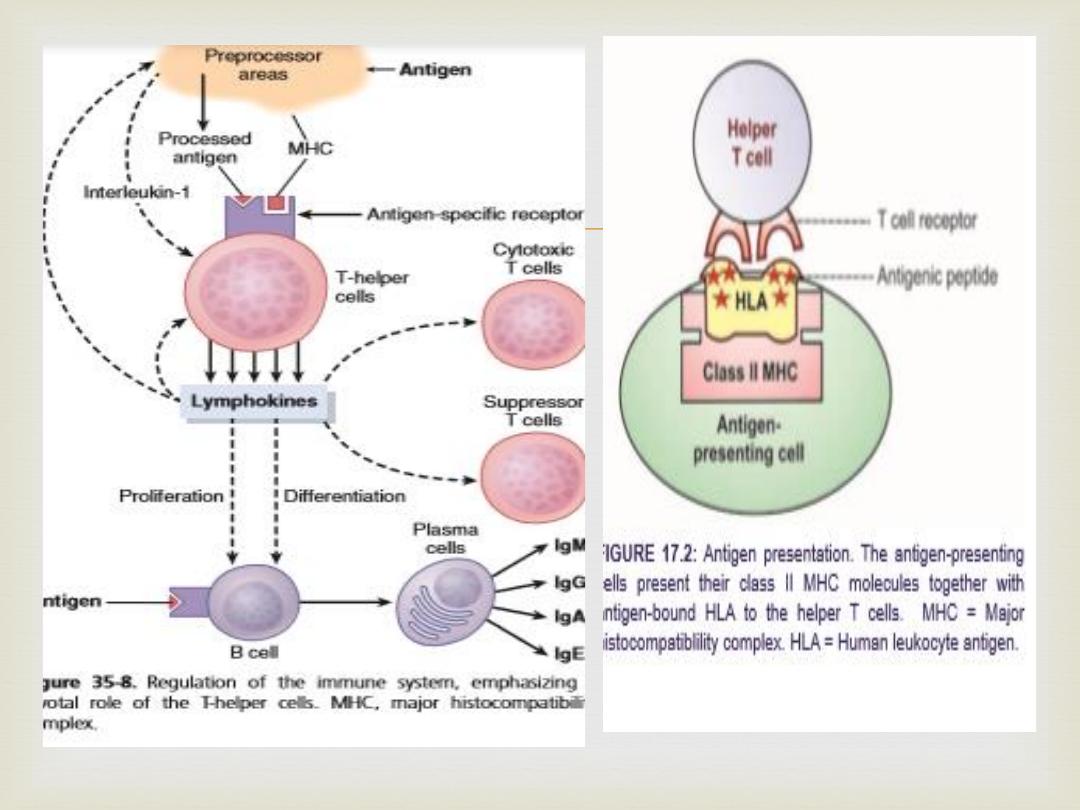
Dr. Suroor Mohamed

1- What is the cell mediated immunity ?
2- Is there any significant part of T cell in our immune response ?
3- Immunization ? What is mean?
4
-
what are the explanation of Allergy and hyper sensitization
?
Objectives….

Cell-mediated immunity
is defined as the immunity developed by cell-mediated
response. It involves several types of cells such as T lymphocytes, macrophages
and natural killer cells and hence the name cell mediated immunity.
Cellular immunity is the major defense mechanism against infections by viruses,
fungi and few bacteria like tubercle bacillus
. It is also responsible for delayed
allergic reactions and the rejection of transplanted tissues.
the invading microbial or non-microbial organisms carry the antigenic materials ,
These antigenic materials are released from invading organisms and are
presented
to the helper T cells
by
antigen-presenting cells.
Like B cells, immunocompetent T cells are activated to form a clone by binding with
a "recognized" antigen. However, unlike B cells, the T cells are not able to bind with
free antigens
. Instead, the antigens must be "
presented"
by macrophages, and a
double recognition must occur. The macrophages engulf the antigens, process them
internally, and then finally display parts of the processed antigens on their external
surface in combination with one of their own (self) proteins
.

ANTIGEN-PRESENTING CELLS
are the special type of cells in the body,
which induce the release of antigenic materials from invading organisms and
later present these materials to the helper T cells
Types of Antigen-Presenting Cells
three types: 1. Macrophages 2. Dendritic cells 3. B lymphocytes.
Among these cells,
macrophages
are the major antigen-presenting cells.
Macrophages are the large phagocytic cells, which digest the invading organisms
to release the antigen. The macrophages are present along with lymphocytes in
almost all the lymphoid tissues.
Dendritic Cells
are non phagocytic in nature.
dendritic cells are classified into three categories:
i. Dendritic cells of spleen, which trap the antigen in blood.
ii. Follicular dendritic cells in lymph nodes, which trap the antigen in the lymph.
iii. Langerhans dendritic cells in skin, which trap the organisms coming in contact
with body surface.
B Lymphocytes
, the B cells function as both antigen-presenting cells and antigen
receiving cells.B cells are the least efficient antigen presenting cells and need to be
activated by helper T cells.

Invading foreign organisms
are either engulfed by macro phages through
phagocytosis or trapped by dendritic cells. Then, the antigen from these organisms is
digested into small peptide products. These products move towards the surface of the
antigen-presenting cells and bind with
human leukocyte anti gen (HLA
). HLA is a
genetic matter present in the molecule of class II major histocompatiblility complex
(MHC), which is situated on the surface of the antigen presenting cells.


The different classes of T cell clones are:
I- Cytotoxic (killer) T cells
, cells that specialize in killing virus-infected, cancer, or foreign graft cells.
One way they accomplish this is by binding to them and inserting a toxic chemical (perform or
others) into the foreign cell's plasma membrane.
II- Helper T cells
are the T cells that act as the "directors" or "managers" of the immune system. Once
activated, they circulate through the body, recruiting other cells to fight the invaders.
For example, helper T cells interact directly with B cells (that have already attached to antigens),
prodding them into more rapid division (clone production) and then signaling for antibody
formation to begin. They also release a variety of cytokine chemicals called
lymphokines
that act
indirectly to rid the body of antigens by (1) stimulating cytotoxic T cells and B cells to grow and
divide; (2) attracting other types of protective white blood cells, such as neutrophils, into the area;
and(3) enhancing the ability of macrophages to engulf and destroy microorganisms.
III- Suppressor Tcells
,
releases chemicals that suppress the activity of both T and B cells. Suppressor
T cells are vital for winding clown and finally stopping the immune response after an antigen has
been successfully inactivated or destroyed. This helps prevent uncontrolled or unnecessary immune
system activity
VI- memory cells;
most of the T cells enlisted to fight in a particular immune response are dead
within a few days. However, a few members of each clone are long-lived memory cells that remain
behind to provide the immunological memory for each antigen encountered and enable the body to
respond quickly to its subsequent invasions.

„
ROLE OF HELPER T CELLS
Helper T cells (CD4 cells) which enter the circulation activate all the other T
cells and B cells. Normal, CD4 count in healthy adults varies between 500
and 1500 per cubic millimeter of blood. Helper T cells are of two types: 1.
Helper-1 (TH1) cells 2. Helper-2 (TH2) cells.
Role of TH1 Cells TH1 cells are concerned with cellular immunity and
secrete two substances:
i.
Interleukin-2, which activates the other T cells.
ii.
ii. Gamma interferon, which stimulates the phagocytic activity of
cytotoxic cells, macrophages and natural killer (NK) cells.
Role of TH2 Cells TH2 cells are concerned with humoral immunity and
secrete interleukin-4 and interleukin-5, which are concerned with:
i. Activation of B cells.
ii.
Proliferation of plasma cells.
iii.
iii. Production of antibodies by plasma cell.
„
ROLE OF CYTOTOXIC T CELLS
Cytotoxic T cells that are activated by
helper T cells, circulate through blood, lymph and lymphatic tissues and
destroy the invading organisms by attacking them directly.

„
NATURAL KILLER CELL
Natural killer (NK) cell is a large granular cell that plays an important role in defense mechanism of the
body, Considered as the third type of lymphocyte, it is often called the non-T, non-B cell
. NK cell is said to be the first line of defense in specific immunity, particularly against viruses . NK cell
kills the invading organisms or the cells of the body without prior sensitization. It is not a phagocytic cell
but its granules contain hydrolytic enzymes such as perforins and granzymes. These hydrolytic enzymes
play an important role in the lysis of cells of invading organisms.
„
CYTOKINES
Cytokines are the hormone-like small proteins acting as intercellular messengers
(cell signaling molecules) by binding to specific receptors of target cells. These non-antibody
proteins are secreted by WBCs and some other types of cells. Their major function is the activation
and regulation of general immune system of the body.
TYPES OF CYTOKINES Depending upon the source of secretion and effects, cytokines are
classified into several types: 1. Interleukins 2. Interferons 3. Tumor necrosis factors
Interleukins (IL)
are the polypeptide cytokines which are produced mainly by
the leukocytes and act on other leukocytes. Types of interleukins, about 16 types
of interleukins are identified. IL-1, IL-2, IL-3, IL-4, IL-5, IL-6 and IL-8 play
important role in the process of immunity.
Interferons (IFN)
are the glycoprotein molecules. These cytokines are considered
as antiviral agents. Types of Interferons are of three types namely, INF-α, INF-β
and INF-γ.
Tumor Necrosis Factors
(TNF) are of three types, TNF-α (cachectin), TNF-β
(
lymphotoxin) and TNF-γ.

„
IMMUNIZATION
Immunization is defined as the procedure by which the body is prepared to fight against a specific
disease. It is used to induce the immune resistance of the body to a specific disease. Immunization is of
two types:
1. Passive immunization
2. Active immunization
.
„
PASSIVE IMMUNIZATION
or immunity is produced without challenging the immune system of the body. It is done by
administration of serum or gamma globulins from a person who is already immunized (affected by
the disease) to a non-immune person. Passive immunization is acquired either naturally or artificially.
Passive Natural Immunization
is acquired from the mother before and after birth. Before birth,
immunity is transferred from mother to the fetus in the form of maternal antibodies (mainly IgG)
through placenta. After birth, the antibodies (IgA) are transferred through breast milk.
the passive immunity is short lived. The significance of passive immunity that is obtained before birth
is the prevention of Rh incompatibility in pregnancy.
Passive Artificial Immunization
is developed by injecting previously prepared antibodies using
serum from humans or animals. Antibodies are obtained from the persons affected by the disease or
from animals, particularly horses which have been immunized artificially. The serum containing the
antibody (antiserum) is administered to people who have developed the disease (therapeutic). It is
also used as a prophylactic measure. Prophylaxis refers to medical or public health procedures to
prevent a disease in people who may be exposed to the disease in a later period.

Active immunization
process of vaccination has been used for many years to cause acquired
immunity against specific diseases. A person can be vaccinated by injecting
dead organisms
that are
no longer
capable of causing disease but which still
have their chemical antigens. This type of vaccination is used to protect
against typhoid fever, whooping cough, diphtheria, and many other types
of bacterial diseases
.
Also, immunity can be achieved
against toxins
that have been treated with
chemicals so
that their toxic nature has been destroyed even though their
antigens for causing immunity are still intact. This procedure is used in
vaccinating against tetanus and other similar toxic diseases.
finally a person can be vaccinated by infection
with live organisms
that
have been "
attenuated."
That is, these organisms either have been grown in
special culture media or have been passed through a series of animals until
they have mutated enough that they will not cause disease but do still carry
the specific antigens. This procedure is used to protect against poliomyelitis,
yellow fever, measles, smallpox, and many other viral diseases
.

Some persons have an "allergic" tendency. Their allergies are called
atopic allergies because they are caused by a non ordinary response
of the immune system. The allergic tendency is genetically passed on
from parent to child, and it is characterized by the presence of large
quantities of IgE antibodies.
Autoimmune Diseases
When the immune system loses its ability to distinguish self-antigen
while stile recognize and attack foreign antigens, the body produces
antibodies (auto antibodies) and sensitized cells that attack and
damage its own tissues. Most common immune diseases are: type I
diabetes mellitus which destroys pancreatic beta cells, and
Rheumatoid arthritis which systematically destroys joints.
Immunodeficiency
The most important acquired immunodeficiency is acquired immune
deficiency syndrome [AIDS] which is caused by a virus transmitted
in blood, semen, vaginal secretions, and saliva. The virus named HIV
(human immunodeficiency virus), specifically targets and destroys
helper T cells, resulting in depression of cell-mediated immunity

„
IMMUNE DEFICIENCY DISEASES
Immune deficiency diseases are a group of diseases in which some components
of immune system is missing or defective. Normally, the defense mechanism
protects the body from invading pathogenic organism. When the defense
mechanism fails or becomes faulty (defective), the organisms of even low
virulence produce severe disease. The organisms, which take advantage of
defective defense mechanism, are called opportunists. Immune deficiency
diseases caused by such opportunists are of two types:
1
. Congenital immune deficiency
2. Acquired immune deficiency diseases
.
„The most common disease of this type is acquired immune deficiency
syndrome (AIDS) is an infectious disease caused by immune deficiency virus
(HIV). A person is diagnosed with AIDS when the CD4 count is below 200 cells
per cubic
millimeter of blood. AIDS is the most common problem throughout
the world because of rapid increase in the number of victims. Infection occurs
when a glycoprotein from HIV binds to surface receptors of T lymphocytes,
monocytes, macrophages and dendritic cells leading to the destruction of these
cells. It causes slow progressive decrease in immune function, resulting in
opportunistic infections of various types.

„
AUTOIMMUNE DISEASES
is defined as a condition in which the immune system mistakenly
attacks body’s own cells and tissues. Normally, an antigen induces the immune response in the
body. The condition in which the immune system fails to give response to an antigen is called
tolerance. This is true with respect to body’s own antigens that are called self antigens or
autoantigens.
Normally, body has the tolerance against self antigen. the tolerance fails or becomes incomplete
against self antigen. This state is called autoimmunity and it leads to the activation of T
lymphocytes or production of autoantibodies from B lymphocytes. The T lymphocytes (cytotoxic
T cells) or autoantibodies attack the body’s normal cells whose surface contains the self antigen or
autoantigen. Thus, the autoimmune disease is produced when body’s normal tolerance decreases
and the immune system fails to recognize the body’s own tissues as ‘self’.
„
COMMON AUTOIMMUNE DISEASES are: 1. Insulin-dependent diabetes mellitus 2. Myasthenia gravis 3.
Hashimoto thyroiditis 4. Graves disease 5. Rheumatoid arthritis
.
1. Insulin-dependent Diabetes Mellitus
Insulin-dependent diabetes mellitus (IDDM) is very
common in childhood and it is due to HLA-linked autoimmunity. Common causes of islet cell
autoantibody against β-cells in the islets of Langerhans in pancreas.
2. Myasthenia Gravis
This neuromuscular disease occurs due to the development of
autoantibodies against the receptors acetylcholine in neuromuscular junction. .
3. Hashimoto Thyroiditis
Hashimoto thyroiditis is common in the late middle-aged women. The
autoantibodies impair the activity of thyroid
4. Graves Disease
In some cases, the autoantibodies activate thyroid-stimulating hormone (TSH)
receptors leading to hyperthy roidism.
5. Rheumatoid Arthritis
is the disease due to chronic inflammation of synovial lining of joints
(synovitis). The synovium becomes thick, leading to the development of swelling around joint
and tendons. The characteristic symptoms are pain and stiffness of joints. The chronic inflamma
tion occurs due to the continuous production of autoantibodies called rheumatoid arthritis factors
(RA factors).

„ALLERGY AND IMMUNOLOGICAL HYPERSENSITIVITY
REACTIONS
The term allergy means hypersensitivity. It is defined as abnormal immune response to a chemical or
physical agent (allergen). During the first exposure to an allergen, the immune response does not
normally produce any reaction in the body. Sensitization or an initial exposure to the allergen is
required for the reaction. So, the subsequent exposure to the allergen causes variety of inflammatory
responses. These responses are called allergic reactions or immunological hypersensitivity reactions.
Immunological hypersensitivity reactions may be innate or acquired. These reactions are mediated
mostly by antibodies. In some conditions, T cells are involved. Common symptoms include sneezing,
itching and skin rashes. However, in some persons the symptoms may be severe. Common allergic
conditions are:
1. Food allergy 2. Allergic rhinitis 3. Bronchial asthma 4. Urticaria
„
ALLERGENS
Any substance that produces the manifestations of allergy is called an allergen. It
may be an antigen or a protein or any other type of substance. Even physical agents can develop
allergy. Allergens are introduced by: 1. Contact (e.g.: chemical substance) 2. Inhalation (e.g.: pollen) 3.
Ingestion (e.g.: food) 4. Injection (e.g.: drug).
Common Allergens
1. Food substances: Wheat, egg, milk and chocolate.
2. Inhalants: Pollen grains, fungi, dust, smoke, perfumes and disagreeable odor.
3. Contactants: Chemical substances, metals, animals and plants.
4. Infectious agents: Parasites, bacteria, viruses and fungi.
5. Drugs: Aspirin and antibiotics
. 6. Physical agents: Cold, heat, light, pressure and radiation. „

Hypersensitivity
ACID
= atopy, cytotoxic, immune complex & delayed

